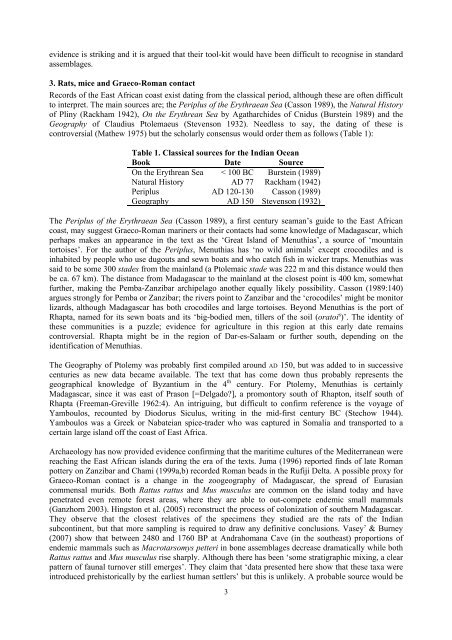Paper for Cambridge 2007 proceedings submit.pdf - Roger Blench
Paper for Cambridge 2007 proceedings submit.pdf - Roger Blench
Paper for Cambridge 2007 proceedings submit.pdf - Roger Blench
Create successful ePaper yourself
Turn your PDF publications into a flip-book with our unique Google optimized e-Paper software.
evidence is striking and it is argued that their tool-kit would have been difficult to recognise in standard<br />
assemblages.<br />
3. Rats, mice and Graeco-Roman contact<br />
Records of the East African coast exist dating from the classical period, although these are often difficult<br />
to interpret. The main sources are; the Periplus of the Erythraean Sea (Casson 1989), the Natural History<br />
of Pliny (Rackham 1942), On the Erythrean Sea by Agatharchides of Cnidus (Burstein 1989) and the<br />
Geography of Claudius Ptolemaeus (Stevenson 1932). Needless to say, the dating of these is<br />
controversial (Mathew 1975) but the scholarly consensus would order them as follows (Table 1):<br />
Table 1. Classical sources <strong>for</strong> the Indian Ocean<br />
Book Date Source<br />
On the Erythrean Sea < 100 BC Burstein (1989)<br />
Natural History AD 77 Rackham (1942)<br />
Periplus AD 120-130 Casson (1989)<br />
Geography AD 150 Stevenson (1932)<br />
The Periplus of the Erythraean Sea (Casson 1989), a first century seaman’s guide to the East African<br />
coast, may suggest Graeco-Roman mariners or their contacts had some knowledge of Madagascar, which<br />
perhaps makes an appearance in the text as the ‘Great Island of Menuthias’, a source of ‘mountain<br />
tortoises’. For the author of the Periplus, Menuthias has ‘no wild animals’ except crocodiles and is<br />
inhabited by people who use dugouts and sewn boats and who catch fish in wicker traps. Menuthias was<br />
said to be some 300 stades from the mainland (a Ptolemaic stade was 222 m and this distance would then<br />
be ca. 67 km). The distance from Madagascar to the mainland at the closest point is 400 km, somewhat<br />
further, making the Pemba-Zanzibar archipelago another equally likely possibility. Casson (1989:140)<br />
argues strongly <strong>for</strong> Pemba or Zanzibar; the rivers point to Zanzibar and the ‘crocodiles’ might be monitor<br />
lizards, although Madagascar has both crocodiles and large tortoises. Beyond Menuthias is the port of<br />
Rhapta, named <strong>for</strong> its sewn boats and its ‘big-bodied men, tillers of the soil (oratoi 6 )’. The identity of<br />
these communities is a puzzle; evidence <strong>for</strong> agriculture in this region at this early date remains<br />
controversial. Rhapta might be in the region of Dar-es-Salaam or further south, depending on the<br />
identification of Menuthias.<br />
The Geography of Ptolemy was probably first compiled around AD 150, but was added to in successive<br />
centuries as new data became available. The text that has come down thus probably represents the<br />
geographical knowledge of Byzantium in the 4 th century. For Ptolemy, Menuthias is certainly<br />
Madagascar, since it was east of Prason [=Delgado?], a promontory south of Rhapton, itself south of<br />
Rhapta (Freeman-Greville 1962:4). An intriguing, but difficult to confirm reference is the voyage of<br />
Yamboulos, recounted by Diodorus Siculus, writing in the mid-first century BC (Stechow 1944).<br />
Yamboulos was a Greek or Nabateian spice-trader who was captured in Somalia and transported to a<br />
certain large island off the coast of East Africa.<br />
Archaeology has now provided evidence confirming that the maritime cultures of the Mediterranean were<br />
reaching the East African islands during the era of the texts. Juma (1996) reported finds of late Roman<br />
pottery on Zanzibar and Chami (1999a,b) recorded Roman beads in the Rufiji Delta. A possible proxy <strong>for</strong><br />
Graeco-Roman contact is a change in the zoogeography of Madagascar, the spread of Eurasian<br />
commensal murids. Both Rattus rattus and Mus musculus are common on the island today and have<br />
penetrated even remote <strong>for</strong>est areas, where they are able to out-compete endemic small mammals<br />
(Ganzhorn 2003). Hingston et al. (2005) reconstruct the process of colonization of southern Madagascar.<br />
They observe that the closest relatives of the specimens they studied are the rats of the Indian<br />
subcontinent, but that more sampling is required to draw any definitive conclusions. Vasey 7 & Burney<br />
(<strong>2007</strong>) show that between 2480 and 1760 BP at Andrahomana Cave (in the southeast) proportions of<br />
endemic mammals such as Macrotarsomys petteri in bone assemblages decrease dramatically while both<br />
Rattus rattus and Mus musculus rise sharply. Although there has been ‘some stratigraphic mixing, a clear<br />
pattern of faunal turnover still emerges’. They claim that ‘data presented here show that these taxa were<br />
introduced prehistorically by the earliest human settlers’ but this is unlikely. A probable source would be<br />
3

















